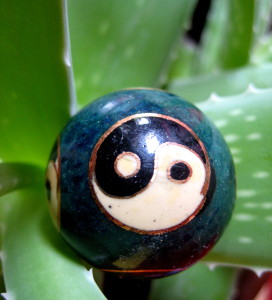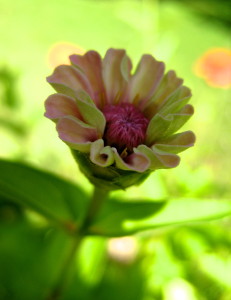
– Photo by Jan Ketchel
When I was a little kid I clearly saw that the ultimate goal of life was death. We were all headed in the same direction, going to the same end. What then was the meaning of life? I’d read the obituaries on the inside front page of the newspaper, studying peoples lives and how they had died, trying to make sense of it all. Then I’d flip to the back inside page and read the comics. Nothing in between was of interest to me. I knew I had to look for answers elsewhere. And so my search for meaning began. Little did I know that I didn’t really have to search at all. The answers were all around me, in the synchronicities of the interconnected universe that we all exist in.
Yesterday, lunchtime arrived. I didn’t really feel hungry, but thought I should probably eat something. I prepared a small lunch. I ate a few bites but still had no appetite. Should I eat now when I have a chance or risk being hungry later when it won’t be appropriate to eat? I was on the fence. I picked up a favorite book, Everyday Tao, looking for guidance. I opened it at random, and received the perfect reading for my situation: Hungry/Full.
Regarding Hunger: “The follower of Tao stays hungry.”
“Those who follow Tao make great achievements if they are so inclined to come out and act in the world. Nevertheless, they always stay hungry, so that they are never complacent. They are always out trying to do better. …those who follow Tao know that hunger is a great motivator.”
“In eating be moderate. Leave a little room in your stomach. Try to stay lean, not for the sake of fashion, but for the sake of health and motivation. The mind grows sluggish on too much rich food and fine wine.”
“However, neither should one become a “hungry ghost,” forever searching the world for something to eat. That is too much the other extreme. Like everything in life, those who follow Tao use moderation, and they use everything they can—even hunger—to further their travels through Tao.”
Regarding Full: “Knowing when one is full: that is wisdom.”
“If you don’t want people to rebel, then stuff their bellies full of food. If you want no wars, then make sure there is enough to eat. When a country is on the brink of ruin, it is because the leaders have taken too much in taxes, conscription, and labor.”
“In a simple life, people eat plain food. They have enough. No one needs to lecture them about balance: nature teaches them. …they learn that for everyone to have enough creates contentment.”
“Eat what is proper. Eat what is right. …avoid excess. Although there are fanatic beliefs about diet, fasting, and ritual, avoid obsession. Eat what is natural. Eat enough, but don’t eat too much. The simple application of that dictum is difficult enough.”
I was fascinated by the response I received—both for myself and as regards the state of our country, reflecting our politics as well as the eating habits and health of the American people—but I really shouldn’t have been. I’ve been experiencing the synchronicities of the universe in alignment with my life for a long time, but nevertheless I get excited all over again every time I encounter the workings of the greater world we live in. Once again, it became clear to me that everything we experience is teaching us to become aware, teaching us how to prepare ourselves to become a part of the greater whole. The meaning of life is becoming part of that whole—one with the Tao—the answer that my chid self so diligently searched for. And one way to experience that is in the synchronicities of life itself.

– Photo by Jan Ketchel
I woke up during the night. “This is the time I usually hear the owl,” I thought. And then I heard the owl hooting in the woods behind our house. “It’s probably hunting,” I thought. And then I heard a flurry of activity, the flicker of swooping wings, the screeching of an animal. “It got one of the rabbits that live in the backyard,” I thought. “Don’t be sad. Let it go, it’s nature at work.” The tussle lasted but a few moments, then it was quiet again.
Once again, I was fascinated by the synchronicities of the universe. Are my thoughts manifesting these things? I wondered. I think a thought, the universe responds. I know I did not cause anything, but I do know that I am part of the greater whole. When I ask the universe for guidance, I am tuning into the greater whole, aligning with intent, and this is why the answers appear so synchronistically. This is what my child self could not grasp, having little concept of the universe, of the oneness of everything.
My child self could not understand that life and death were of the same energetic configuration, just different manifestations of the greater whole that we all are. Now, having had many experiences of the oneness of all things, I feel myself as part of everything. But even so, I tend to forget when dealing with the mundanities of life. We are all capable of forgetting even the most transformational of experiences when in the throes of life and what it challenges us with. But if we repeatedly bring our attention back to those experiences, back to our awareness of our oneness, we enter a new phase of experience.
If we remember that we too are the universe, we insert ourselves in alignment with synchronicity. Once we are open and receptive, we experience synchronicities everywhere. We hear them. We dream them. We read them. We speak them. We hear them spoken around us, reverberating through the interconnectedness that we all are. When we experience our oneness we are in the Tao. And then life is not so daunting. Nor is death. It all becomes a fascinating experience.

– Photo by Jan Ketchel
In the Tao, in alignment with the universe, the mysteries of life—what lies between the obits and the comics—are no longer mysteries. Everything is us, in us, around us. We are interconnected with everything else, everyone else. In energetic alignment we experience our oneness with everything, and the synchronicities come, because we are fully available to receive them.
From the Tao,
Jan
As I write, a squirrel comes knocking at the window, a hickory nut filling its mouth. “Hello Squirrel, I see you are in the Tao, preparing for the winter ahead.” The owl eating the rabbit, the squirrel gathering nuts, they are in alignment with nature. Are we?
Quotes from: Everyday Tao—Living with Balance and Harmony by Deng Ming-Dao, pp.140-141




